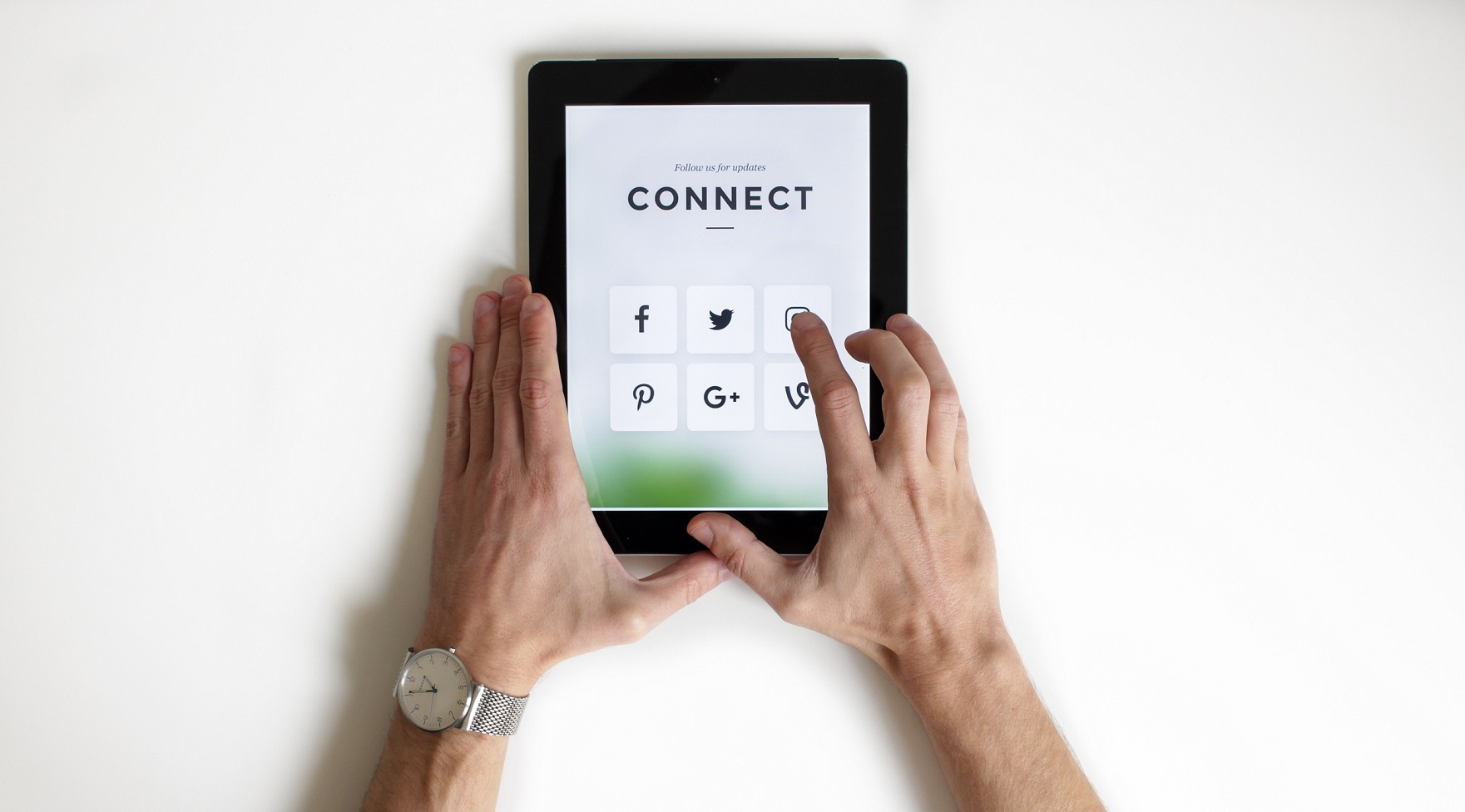
This is a guest post from Lucia Fontaina-Powell. Lucia is the marketing director of Quuu and host of the Conversations with Quuu podcast.
I recently got chatting to a friend of a friend at a party. She was a freelance writer, but she’d recently moved to London from Singapore and was struggling to find work.
In Singapore, she’d had a permanent role at a successful food blog, meaning she was essentially paid to eat at trendy restaurants, then write about it (i.e. winning at life). Unfortunately, it was much harder to find such opportunities in London, and she was making do with small gigs here and there, usually for much less exciting publications.
“I’m doing a lot of B2B tech,” she winced, “because that’s where all the money’s at.”
It’s true. So why the wince?
Because B2B is boring. At least, that’s what years of dry eBooks and yawn-inducing whitepapers would have us believe. Convincing an IT manager to download a data storage platform is hardly sexy, is it?
But here’s where it gets interesting: even if your product’s not ‘sexy,’ your marketing can be. In this post, I’m going to explain how by sharing five things B2B brands can do to shake up their marketing strategies. From my experience growing content curation and promotion platform Quuu, and consulting for other SaaS startups,* I’ve identified some relatively simple principles that will take your B2B marketing from Mia Thermopolis to Princess of Genovia real quick.
They are:
- Steal
- Be real
- Make it pop
- Make it over
- Give it some chat
Let’s take a look at how these principles can relate to your marketing strategy, with specific use cases and real-life examples from successful brands.
*For the record, all genuinely sexy products 😉
1) Steal
Number one on our list of B2B marketing commandments: thou shalt steal from other industries.
Remember what I said about dry eBooks and yawn-inducing whitepapers? While B2B marketers have spent many years worshipping at their altar, recent research reveals that these types of content are falling out of favor.
In a survey conducted by Ascend2 in 2018, the following types of content were found to produce the highest number of leads:
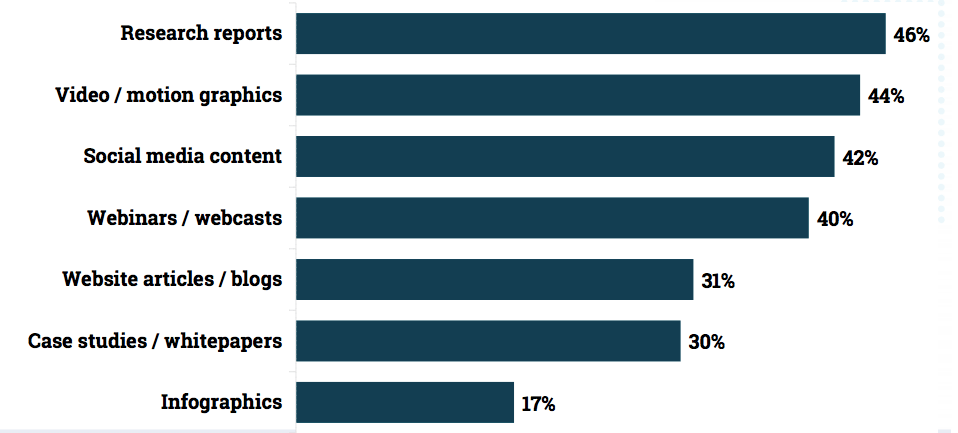
Although more ‘traditionally B2B’ research reports take the top spot, video and social media content have quickly climbed the ranks. This is a clear indicator that the B2B marketing industry has changed. Namely, lots of the action is taking place on social media – which, as any B2B marketer will tell you, can be a tough nut to crack. The problem is, a whitepaper on the financial services industry doesn’t exactly scream ‘viral.’
A B2B marketing strategy should be highly data-driven: before you do anything else, conduct in-depth customer research and competitor analysis. This will help you understand your audience and the market you’re operating in, then identify the topics they care about. However, when you get to the creative stage – deciding how to communicate those topics – taking inspiration from outside of your industry can be your secret weapon.
I do this all the time when I’m developing a content strategy, borrowing ideas and tactics from social media natives in high-growth industries. For example, the beauty industry has seen explosive growth in the last few years, largely thanks to social media. Without Instagram, a brand like Kylie Cosmetics wouldn’t even exist. Key to this growth is the reversal of traditional marketing relationships; the beauty industry has flipped business-to-consumer to consumer-to-business, putting the customer at the center of – well, everything. Brands like Glossier don’t just post a bit of user-generated-content on social media; their very products are developed in response to social media.
https://www.instagram.com/p/Bw0EEUWBpDO/
The phenomenon of unboxing videos has played a huge role in this reversal. Thanks to the internet and social media, consumers now hold the power, since they have a platform to voice their opinions of a brand and experiences using their products. Of course, businesses were quick to tap into this trend and use it to their advantage (like Birchbox).
This brings us onto one of my favorite examples of a B2B brand pinching marketing ideas from another industry: Zaius’s Marketing Unboxed video series.
Zaius is a CRM for eCommerce brands, so their customers would have been very familiar with the unboxing trend. However, being a software company, Zaius couldn’t give their customers a physical product to unbox.
So they thought a bit outside the box (sorry, I couldn’t resist), using the unboxing concept to ‘unpack’ the marketing strategies of successful B2C brands. What I loved about this series was that it took a B2B content staple (analyzing marketing strategies), but presented it in a novel, imaginative way (i.e. not a standard blog post).
It’s important to note that stealing from other industries doesn’t just mean jumping on random social media trends; you still have to be strategic about it. Zaius picked a trend that would resonate with their target audience (eCommerce brands), as well as a medium with a proven success rate (video content). Furthermore, it was perfectly timed for the rise of video content on LinkedIn.
2) Be real
For our second mantra, ‘be real’, we can also look to consumer brands to inspire our B2B marketing.
If there’s one word that sums up the current mood on social media, it’s ‘authenticity’. There’s been a huge backlash against the superficial aspects of social media (fake followers, airbrushed photos, sponsored posts), which has raised the bar for marketers. Consumers are savvier and more mistrustful than ever, so to truly connect with them online, businesses must have integrity.
The most exciting businesses on social media today have made this the core of their branding. If I had to play a word association game with some of my favorites, here’s what I’d say:
Glossier: Authenticity
Glossier (“skincare first, makeup second”) ditch the airbrushing in favor of natural beauty.
https://www.instagram.com/p/Bw20diMBrDb/
Chromat: Personality
Swimwear label Chromat are reacting against the fashion industry’s unhealthy standards in a glorious celebration of individual bodies.
https://www.instagram.com/p/Bw5g5I_Dkg7/
Everlane: Transparency
Sustainable fashion brand Everlane publish the “true cost” behind each item of clothing, from materials, to manufacturing, to transportation.
https://www.instagram.com/p/BwkD80eFDxz/
How to apply authenticity to B2B marketing? Stop thinking business to business, and start thinking human to human. I’ve mentioned that customer research is a vital part of strategy and here’s why: conducting surveys or face-to-face interviews, then fleshing out detailed customer personas, will help us all ditch terms like ‘enterprise solutions’ for good. To build a successful brand nowadays, you have to stop selling to Agency X and start speaking to Tom, Agency X’s Social Media Manager, who does jigsaw puzzles to unwind after particularly stressful client meetings and likes eating peanut butter out of the jar.
This isn’t to say that you should switch your whole blogging strategy to offer your clients advice on their dating lives, but there’s room to acknowledge the human side of doing business.
For example, Quuu had a frankly quite rubbish 2018. A new product launch hadn’t gone to plan, growth had stalled, and our customers weren’t happy. Instead of attempting to cover up our failures, we owned up to them.
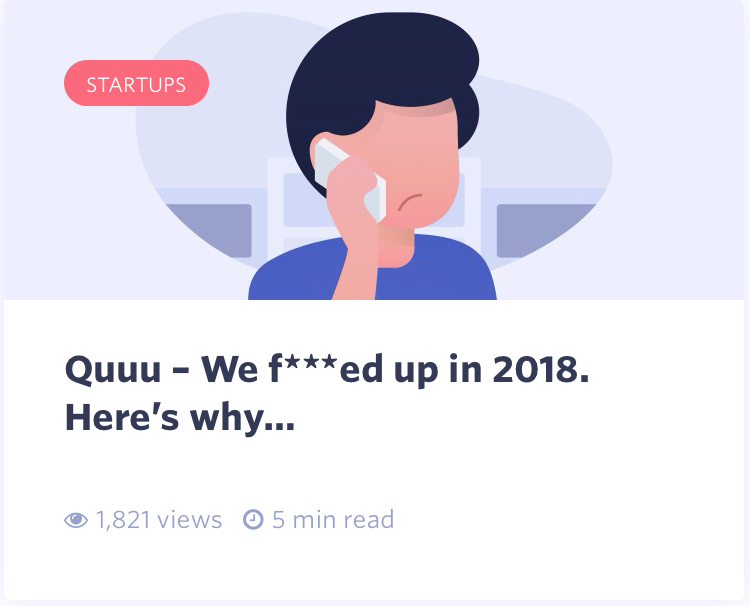
We published an honest account of where we’d gone wrong, what other startups could learn from us, and how we were going to do a better job in 2019. It was one of our most popular blog posts of all time. ‘People and culture’ is one of four pillars we use in our content strategy, and we created an entire podcast series interviewing marketers and entrepreneurs about topics like work-life balance and diversity in tech.
As we saw with Glossier, Chromat and Everlane, this principle can have a pervasive effect over your entire branding and marketing, rather than being restricted to the odd piece of content here and there. Buffer provides a really good example of this for B2B: they’ve developed a tone of voice that feels friendly, approachable and human, and most of their communications are personalized – we always know we’re talking to a real person at the other end of the line.
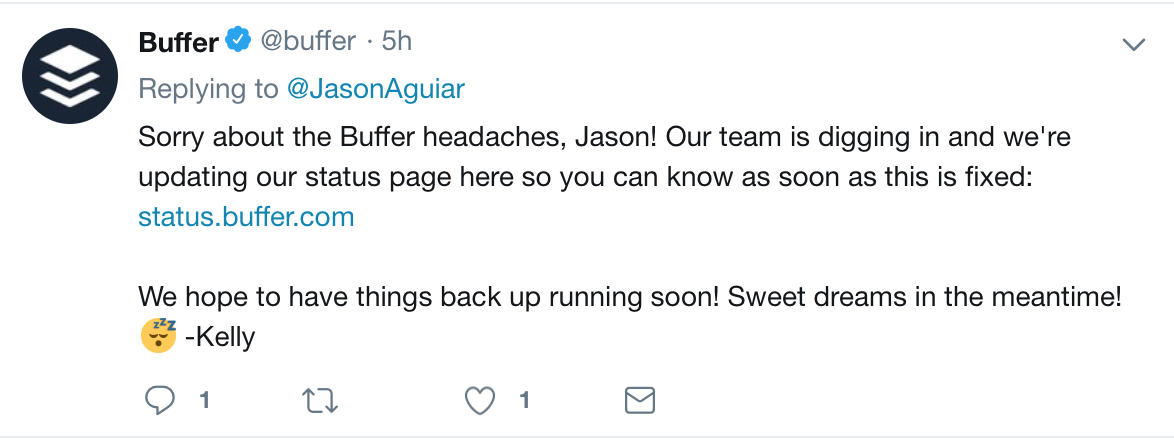
3) Make it pop
Our first two principles feed in nicely to our third: tapping into pop culture to reach a new audience and engage your existing customers.
We’ve talked about stealing ideas from unexpected places and recognizing the human-to-human in B2B. Incorporating pop culture into your marketing combines the two.
You don’t need me to tell you that digital marketing is a constant fight to get noticed. The Internet is only getting more saturated with content, and the amount of brands joining the fray seems exponential. This can feel demoralizing. Have you ever come up with a fantastic content idea, only to find out someone’s already done it? Me too.
However, that’s not to say you should park the idea. Maybe you just need a fresh angle. Pop culture offers a whole bunch of ways for you to reframe your subject matter as something completely original, not to mention the opportunity to hijack a trending topic and significantly expand your reach, if well executed.
Again, this is a tactic we’ve used at Quuu. When Ariana Grande’s ‘thank u, next’ almost broke the internet, I had a brainwave. That’s how the blog post Content marketing lessons from Ariana Grande’s ‘thank u, next’ came into existence. It was another one of our blogging smash hits, instantly doubling our traffic from the month before, and continuing to stack up views even after the buzz around the song died down.
A lot of that traffic came from Facebook, and it’s worth noting that this type of content is particularly well-suited to social media. Although ‘thank u, next’ would have been trending on search engines, we weren’t trying to hijack the trend from an SEO point of view (it wouldn’t match the search intent of our target customer, even if they were Ariana Grande fans!). However, it was a highly clickable and shareable post, which quickly started doing the rounds among B2B content marketers.
B2B marketing agency Foundation Inc had the same idea with their brilliant blog post, What Marie Kondo Can Teach B2B Companies About Content Creation. At a beauty industry event recently, I was impressed to see visual booking platform BeautyStack take this concept a step further: they’d created a physical ‘zine’ to engage their ‘Beauty Pro’ audience, featuring a series of interviews with beauty entrepreneurs who’d set up their own businesses.
Although this strategy sounds super fun, remember that it can be tricky to pull off. The pop culture angle should act as a garnish to the real value of your content, rather than being the main meal itself.
4) Make it over
While you want to achieve brand consistency throughout your marketing, it’s important to review your activities on a regular basis. Does the image you present to the world still represent your core product offering? Are you keeping up with current trends? Are you truly connecting with your audience?
You could have the best content in the world, but if your website has as much pizazz as an Excel spreadsheet, no one’s going to read it. Design is crucial to marketing in the digital age, and something that’s worth investing serious money in if you don’t have the skills yourself.
In B2B tech, you might find yourself marketing software that even you don’t fully understand, let alone your customers! Design is the first port-of-call for making your product accessible – from the app itself, right through to your social media posts.
Again, it’s worth taking a leaf out of consumer brands’ books here. Intercom has done this really well. Although their blog covers business-related topics, like software engineering, its design has the feel of a lifestyle magazine. As a result, their content feels friendly and approachable – which is, in fact, right in line with their brand values as a live chat customer support platform.
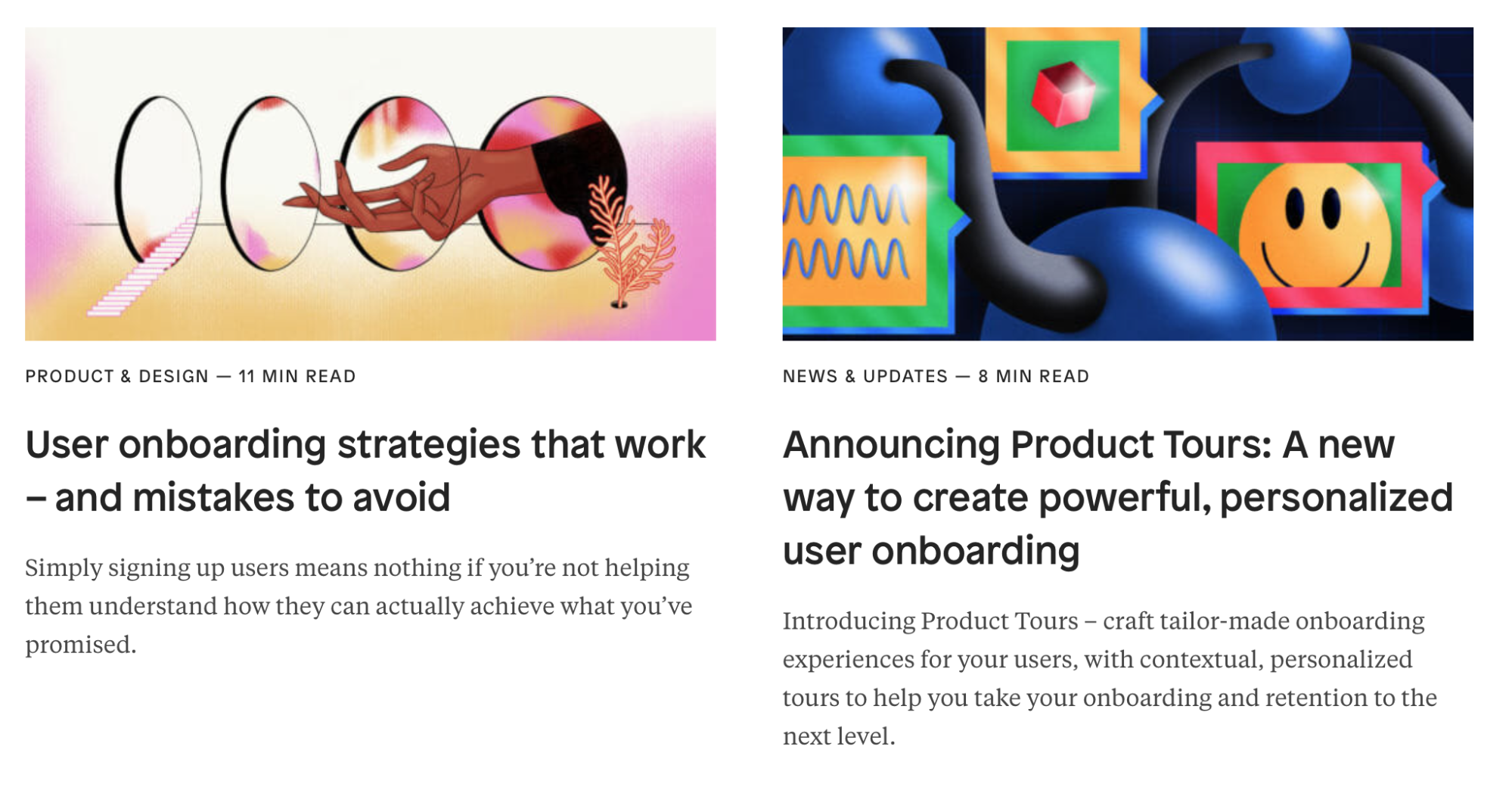
A trend I’m really excited about right now is the shift away from the polished aesthetic made popular by Instagram, which extends to design, not just selfies. One of my favourite examples is The Next Web, who gave their newsletter a makeover that “embraced their inner trash.” It’s also interesting to see new companies like Trippin using more retro logos. If you’re just starting a business, you’d be wise to bear in mind this turning of the tides.
5) Give it some chat
If I had a dollar for every time I’ve said this, but…social media should be social. A mistake lots of B2B brands make is to think of social media as a receptacle for your content. You write a blog post, hit publish, and stick it all over your social profiles. In 2019, this strategy won’t get you very far.
To build an engaged audience, you need to be part of the conversation. That means following and interacting with other accounts, jumping into the comments section, and generally building an active, rather than passive, presence. You should also be using the language of social media (for example, GIFs and memes) to appear relevant and relatable to your audience there.
It’s vital that you have a documented tone of voice to pull this off, especially as your business grows and you have multiple team members handling social. If you’re not sure what this means, check out this handy guide and template from CoSchedule.
What this looks like in practice
- As Facebook pivots from ‘town square’ to ‘living room,’ private communities are becoming increasingly valuable marketing assets. If you haven’t already, I highly recommend starting a Facebook or Slack group where you can chat to your customers on a daily basis.
- Don’t let your followers feel like they’re talking to a brick wall. Respond to every post, comment or tweet directed at you, thank people for sharing your content or mentioning you, ask questions, and run polls.
- Be reactive: which meme is everyone using right now? If something’s trending, think about how you can put a spin on it, like we did for this New Year post on Quuu’s Facebook:
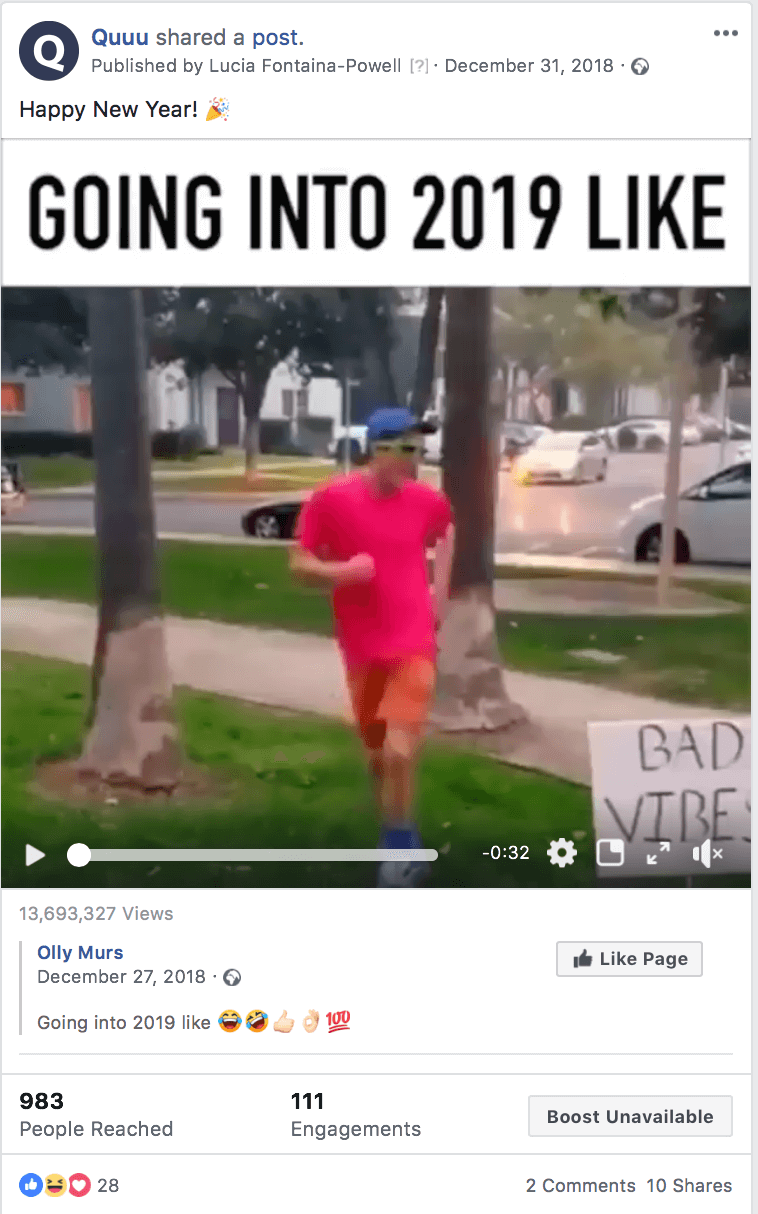
Conclusion
To recap, we’ve covered five ways you can shake up your B2B marketing to stay ahead of the curve and connect with your target audience:
- Steal ideas from industries that are completely different from yours
- Think less business-to-business and more human-to-human
- Reference pop culture to create content that stands out from the crowd
- Continually review your design and branding to stay current
- Be conversational and reactive on social media
Hopefully, you’re now armed with a ton of ideas and references to inspire your marketing in 2019 and beyond. Are there any other principles or real-life examples you’d add to the list? I’d love to hear from you.